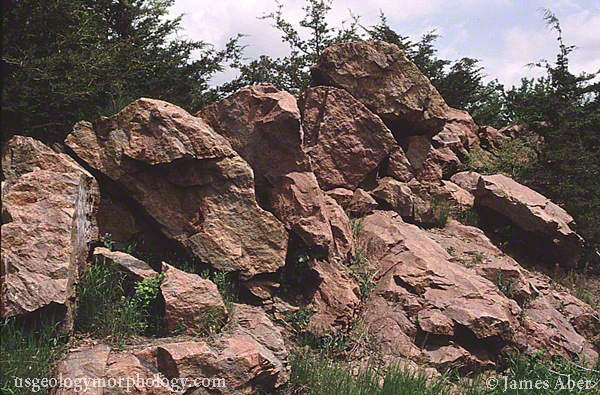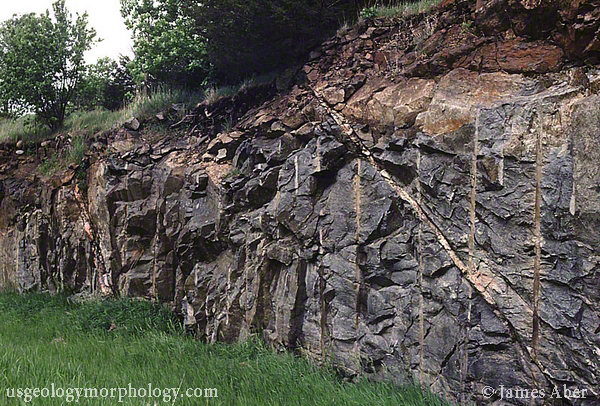The Archean Terranes of Minnesota (cont.)
4.2 Montevideo Block: Lithography
The Montevideo block of the Minnesota River Valley subprovince lies south of the Appleton Geophysical Lineament, which separates it from the Benson block and north of the Yellow Medicine Shear Zone, which marks the northern boundary of the Morton Block (figure 2-1). Outcrops of Archean rocks are more abundant than in the Benson block and studies have been more numerous and extensive. Like the other blocks, its boundaries, in the absence of large outcrops, have been chiefly determined with the help of the aeromagnetic anomaly map (figure 4-1).
This block is best known for the rock commonly called Montevideo gneiss, a pink to red rock with straight banding, composed of plagioclase (oligoclase), microcline and some biotite. However several other rocks, including other gneisses are present in the area, which proves to be complex, with many local variations.

Figure 4.2-1. Montevideo gneiss
Montevideo granite gneiss near Montevideo, MN. By permission of James Aber. © James Aber (*)

Figure 4.2-2. Mafic gneiss near Granite Falls, Minnesota.
Note the pink pegmatite veins at left and right. By permission of James Aber. © James Aber (*)
Lund (1956) wrote the first modern and comprehensive modal analysis of the rocks of the Montevideo and Granite Falls areas and proposed a relative chronology before the development of radiometric dating. He considered an older "basic complex" of gabbro gneiss, diorite gneiss and a garnet-biotite gneiss he named Granite Falls garnetiferous quartz-diorite gneiss; this basic complex was remaining as intrusions in a younger granite gneiss, the Montevideo granite gneiss, where he distinguished two varieties (leucoadamellite and leucogranite). He also recognized younger "post-granite intrusives": basalt and diabase in dikes and a "late granite" in a small area northwest of Granite Falls.
Goldich et al. (1961) kept most of Lund's classification and attempted the first radiometric dating in the region, with the K-Ar and Rb-Sr methods (see below). He completed Lund's late granite name as "late granite of section 28", underlining the fact it is the youngest igneous rock of the region, since it cuts a basalt dike as well as the Montevideo gneiss.
Himmelberg and Phinney (1967) and Himmelberg (1968) revised the rock classification and their mapping. Lund's gabbro and diorite gneiss became a hornblende-pyroxene gneiss, a gray-to-black medium-grained rock, varying from banded gneiss to amphibolite. Lund's Granite Falls garnetiferous quartz-diorite gneiss was renamed garnet-biotite gneiss and divided into two subseries: a dark-gray medium-grained foliated gneiss and a light-gray, coarse granular gneiss. The Montevideo granite gneiss was simply called granitic gneiss. In some areas, rocks previously mapped by Lund as granite gneiss or garnetiferous quartz-diorite gneiss were analyzed by Himmelberg (1968) as hornblende-pyroxene gneiss. The new category Himmelberg (1968) introduced in the Granite Falls area, the interlayered gneiss, southeast of the town of Granite Falls is now considered part of the Morton block. Three types of dike rocks were recognized instead of two: tholeiitic diabase (dark gray, medium-grained, composed of plagioclase, augite and oxide), hornblende andesite (gray to black, with plagioclase-quartz phenocrysts in a plagioclase-hornblende-biotite matrix) and olivine diabase (black; composed of olivine, plagioclase, augite, pyroxene and oxide). Lund's late granite was now identified as a "small adamellite body", a pink, medium-grained rock made of plagioclase, microcline, quartz and biotite. The term "adamellite" was used according to Johannsen's 1939 classification; in the IUGS classification presently in use, such a rock would be called a granite (with equal parts of plagioclase and alkali feldspar and 25% quartz). Studying the mineral assemblages of the three main gneissic units (hornblende-pyroxene, garnet-biotite and granitic gneisses), Himmelberg and Phinney (1967) determined they belonged for the most part to the granulite facies (both pyroxene granulite and hornblende granulite subfacies), and for a smaller part to the amphibolite facies. They also noticed the results of some retrograde metamorphism.
Goldich et al. (1980a), focusing on the Granite Falls area, revised both Lund's and Himmelberg's classifications for the gneisses. They distinguished two main categories: the mafic and felsic gneisses. The mafic gneisses included : (1) metagabbro (Lund's gabbro gneiss) , (2) amphibolite (of tholeiitic or basaltic komatiitic composition; corresponding to some hornblende-pyroxene gneiss of Himmelberg) and (3) layered gneiss (either hornblende-pyroxene gneiss or biotite-pyroxene as with Himmelberg) of suggested metasedimentary origin. The felsic gneisses, i.e. the Montevideo gneiss, were divided into four groups: (1) dark gray to reddish-brown granodiorite gneiss, (2) gray trondhjemite or tonalite gneiss (close to the granodioritic gneiss), (3) red adamellite (the "massive leucocratic phase", whose red color is due to the presence of hematite) and (4) pegmatite granite, associated with the adamellite.
Bauer (1980), while studying the multiphase deformation of the Granite Falls-Montevideo area, followed Goldich et al. (1980)with some differences. The mafic gneisses were divided into four types: (1) metagabbro, (2) amphibolite (which he thought was emplaced in sills and dikes), (3) hornblende-pyroxene gneiss, (4) metagraywacke gneiss (Himmelberg's garnet-biotite gneiss). Within the felsic gneisses, Bauer regrouped the granodiorite and tonalite gneisses into a single banded granodiorite gneiss, mentioned Goldich's adamellite as the "massive granitic phase" but used the same name than Goldich for the granite pegmatite.
Figure 4.2-3. Folds in Montevideo gneiss
Photos and descriptions from Bauer et al. (2011, p 54, fig. 4-4A and 4-4E, © Geological Society of America). Left: Montevideo granite gneiss near Granite Falls showing two generations of folds, F2 and F3; this sample contains hypersthene, hence the green color. Right: Montevideo gneiss near Montevideo: pink granitic veins intrude foliated gray granodiorite and are folded by F1 folds.
Bauer and Himmelberg (1993) gave one of the latest comprehensive and detailed rock classifications of the Minnesota River Valley subprovince and of the Montevideo block in particular. They considered here four major groups: felsic gneiss, mafic gneiss, metagraywacke gneiss and interlayered gneiss (found only southeast of Granite Falls). The felsic gneisses were still subdivided into three types: the abovementioned banded granodiorite gneiss, a medium-grained granite gneiss (restricted to the Granite Falls area, the former pegmatite gneiss) and a medium-grained granite gneiss in the Montevideo region (the red massive granitic phase or adamellite). There was no terminology change for the mafic gneisses: metagabbro, hornblende-pyroxene gneiss and amphibolite. As in Bauer (1980), Himmelberg's garnet-biotite gneiss (1968) was still interpreted as a metagraywacke gneiss. Among the later intrusives the rocks of the later dikes were unchanged since Himmelberg (1968): tholeiitic diabase, hornblende diabase and olivine diabase, but Goldich's granite of section 28 (Lund's late granite and Himmelberg's small adamellite body) was now described as an epizonal anorogenic granite.
The observations above were made in the outcrops of the valley; the rest of the Montevideo block, as noted, is known indirectly. However some drill holes confirm its inferred nature and limits. Southwick et al. (1990) conducted several drill holes within 10 km south of the Appleton Geophysical Lineament. They discovered biotite granite, pink and gray granite, biotite paragneiss and leucocratic gneiss. A hole in Sibley State Park (northern Kandiyohi County), a few kilometers west of the Penokean tectonic front, revealed granitoid gneiss.
(*) Photos from Dr. James Aber's webpage "Morton Gneiss, Minnesota"
http://academic.emporia.edu/aberjame/tectonic/morton_gneiss/morton.htm.
